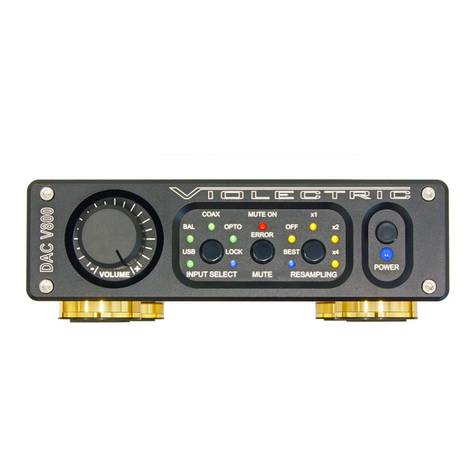10
GENERAL INFORMATION
VIOLECTRIC DAC V850 is a top-range D/A converter, distinguished by
its resampling unit, its 32-bit double mono converters and very particular
analog output stages. By means of their specially designed, variable
low-noise and low-distortion circuitry, the DAC V850 fulfils even highest
demands. As an option, the volume control, input selection and the
resampling functionality may be remote controlled.
Features:
- four switchable digital inputs:
- transformer balanced via XLR (AES 3), 24 bit / 192 kHz
- coaxial via RCA (S/P-DIF, AES-3id), 24 bit / 192 kHz
- optical via TOS-Link, 24 bit / 192 kHz
- USB 24/192 input Style B, transformer-coupled, X-mos based
- coaxial digital output which may be volume controlled
- LED signaling for active input, lock, error/mute and resampling mode
- resampling / upsampling by multipliers x1, x2, x4 and "BEST"
- 32 bit double-mono converters ( 2 converters per channel )
- Delta-Sigma D/A converter with 120 dB dynamic range / -112 dB THD
- output level adjustable on the front panel
- sophisticated analog output stages, max. dyn. range / min. distortion
- digitally operated output level control (32 bit processing)
- additional internal maximum-level jumpers: +24 /18 /15 /12 /6 dBu,
ex works preset to +15 dBu (unbalanced out: 9 dB less)
- high-quality op-amps along the signal path
- high-quality MKP capacitors along the signal path
- 0,1 / 1 % metal film resistors throughout the unit
- balanced signals from the D/A converters to the outputs
- analog outputs electronically balanced via XLR, unbalanced via RCA
- supersized toroidal transformer
- elaborate supply voltage, low ERS caps for filtering and stabilization
- Nextel-coated, thick-walled aluminum case
- solid 8mm aluminum front panel, BLACK or SILVER, laser-engraved




























